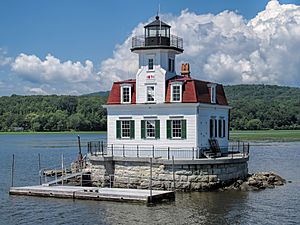Esopus Meadows Light facts for kids
 |
|
| 2011 | |
|
|
|
| Location | West side of Hudson River, Esopus, New York |
|---|---|
| Coordinates | 41°52′6.2″N 73°56′29.8″W / 41.868389°N 73.941611°W |
| Year first constructed | 1839 |
| Year first lit | 1872 (current tower) |
| Automated | 1965 |
| Deactivated | 1965–2003 |
| Foundation | Granite pier on piles |
| Construction | Wood |
| Tower shape | Octagonal on square house |
| Markings / pattern | White house with red mansard roof |
| Focal height | 52 feet (16 m) |
| Original lens | 5th order Fresnel lens, 1872 |
| Range | 6 nautical miles (11 km; 6.9 mi) |
| Characteristic | Flashing White, 2.5s |
| Fog signal | Bell (Removed) |
| Admiralty number | J1140.08 |
| ARLHS number | USA-276 |
| USCG number | 1-38155 |
The Esopus Meadows Lighthouse is a special building on the Hudson River in Esopus, New York. People sometimes call it the "Maid of the Meadows." It's an active lighthouse, which means it still helps boats navigate. This lighthouse stands right in the river, built on a strong granite base. You can only reach it by boat!
Contents
A Look Back: The Lighthouse's Story
The first lighthouse here started being built in 1838. The town of Esopus sold the land to the U.S. government for just $1. The government spent $6,000 to build it. This first light began working in 1839. It looked like another lighthouse, the Rondout Light, further north.
However, by 1867, floods and ice badly damaged the building. So, in 1870, money was set aside for a brand new lighthouse.
The Current Lighthouse
The lighthouse you see today was finished in 1871. It's special because it's the last wooden lighthouse on the Hudson River. It's also the only one with a "clapboard" exterior, which means it has overlapping wooden boards on the outside. The light in this new building was turned on in 1872.
This lighthouse was designed by Albert Dow, a famous architect from Vermont. It has "sister lights" that look similar. These include the Rose Island Light, Sabin Point, Pomham Rocks, and Colchester Reef.
In 1965, the Esopus Meadows Light was closed. By the 1990s, it was in bad shape. The biggest problem was its foundation, which was falling apart because of ice damage.
Saving the Lighthouse
In 1990, a group called the Save Esopus Lighthouse Commission stepped in. They leased the lighthouse from the United States Coast Guard. Their goal was to restore it.
They worked hard, and in September 2002, they officially took ownership. This happened as part of a special program called the National Historic Lighthouse Preservation Act. Because of its importance, the lighthouse was added to the National Register of Historic Places in 1979.
Today, the Esopus Meadows Light is shown on the NOAA Chart 12347. This chart helps boats find their way on the water.
Images for kids




